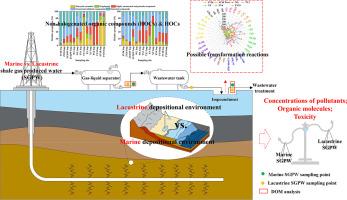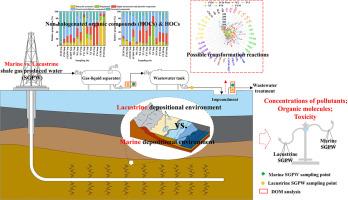Greater environmental risk of shale gas produced water from lacustrine than marine sources in Fuling shale gas field, China: Insights from inorganic compounds, dissolved organic matter, and halogenated organic compounds
IF 11.4
1区 环境科学与生态学
Q1 ENGINEERING, ENVIRONMENTAL
引用次数: 0
Abstract
Lacustrine shale gas represents a promising frontier in the future development of shale gas resources. However, research on the characterization of lacustrine shale gas produced water (SGPW) remains scarce. In this study, we characterized the geochemical properties of both marine and lacustrine SGPW (MSGPW and LSGPW) and assessed their dissolved organic matter (DOM) components using fluorescence EEM spectroscopy. Additionally, we employed Fourier-transform ion cyclotron resonance mass spectrometry (FT-ICR MS) to analyze halogenated organic compounds (HOCs) and non-HOCs in SGPW, as well as their transformations during storage in open impoundments. Pollutants in LSGPW generally had higher concentrations and greater fluctuations compared to those in MSGPW. Our findings from EEM spectroscopy and FT-ICR MS revealed that phenolic compounds may be important components of DOM in all SGPW. Moreover, the number of detected unique molecules in LSGPW was greater than in MSGPW. CHO or CHOS compounds dominated in non-HOCs, with LSGPW exhibiting generally higher DBE, modified aromaticity index (AImod), nominal oxidation state of carbon (NOSC), double bond equivalent minus oxygen per carbon ((DBE-O)/C) values, and lower H/C values compared to MSGPW, while unsaturated aliphatic compounds typically dominated in HOCs. Furthermore, we employed 37 transformation reactions that might occur during SGPW storage and found that oxygen addition and dealkyl group reactions were predominant, with these two types of reactions occurring more frequently in LSGPW than in MSGPW. LSGPW exhibited higher toxicity compared to MSGPW, with toxicity positively correlated with the concentrations of inorganic salts and organic substances with higher AImod, NOSC, and (DBE-O)/C. These findings contribute to a more comprehensive understanding of LSGPW, enabling the design and implementation of more rational disposal measures to effectively mitigate its potential environmental risks.


中国涪陵页岩气田湖沼源页岩气产水的环境风险大于海洋源页岩气产水:无机化合物、溶解有机物和卤代有机化合物的启示
湖底页岩气是未来页岩气资源开发的一个前景广阔的前沿领域。然而,关于湖底页岩气产水(SGPW)特性的研究仍然很少。在本研究中,我们对海洋和湖沼页岩气产水(MSGPW 和 LSGPW)的地球化学特性进行了表征,并利用荧光 EEM 光谱评估了其溶解有机物(DOM)成分。此外,我们还采用傅立叶变换离子回旋共振质谱法(FT-ICR MS)分析了 SGPW 中的卤代有机化合物(HOCs)和非 HOCs,以及它们在露天蓄水池中储存期间的转化情况。与 MSGPW 中的污染物相比,LSGPW 中的污染物浓度通常更高,波动也更大。EEM 光谱和 FT-ICR MS 的研究结果表明,酚类化合物可能是所有 SGPW 中 DOM 的重要组成部分。此外,在 LSGPW 中检测到的独特分子数量多于 MSGPW。CHO 或 CHOS 化合物在非 HOCs 中占主导地位,与 MSGPW 相比,LSGPW 的 DBE、改良芳香指数(AImod)、碳的名义氧化态(NOSC)、双键当量减去每碳含氧量((DBE-O)/C)值普遍较高,H/C 值较低,而不饱和脂肪族化合物通常在 HOCs 中占主导地位。此外,我们还采用了 37 种在 SGPW 储藏过程中可能发生的转化反应,发现氧加成和脱烷基反应占主导地位,这两种反应在 LSGPW 中发生的频率高于 MSGPW。与 MSGPW 相比,LSGPW 表现出更高的毒性,毒性与无机盐和 AImod、NOSC 和 (DBE-O)/C 较高的有机物质的浓度呈正相关。这些发现有助于更全面地了解 LSGPW,从而设计和实施更合理的处置措施,有效降低其潜在的环境风险。
本文章由计算机程序翻译,如有差异,请以英文原文为准。
求助全文
约1分钟内获得全文
求助全文
来源期刊

Water Research
环境科学-工程:环境
CiteScore
20.80
自引率
9.40%
发文量
1307
审稿时长
38 days
期刊介绍:
Water Research, along with its open access companion journal Water Research X, serves as a platform for publishing original research papers covering various aspects of the science and technology related to the anthropogenic water cycle, water quality, and its management worldwide. The audience targeted by the journal comprises biologists, chemical engineers, chemists, civil engineers, environmental engineers, limnologists, and microbiologists. The scope of the journal include:
•Treatment processes for water and wastewaters (municipal, agricultural, industrial, and on-site treatment), including resource recovery and residuals management;
•Urban hydrology including sewer systems, stormwater management, and green infrastructure;
•Drinking water treatment and distribution;
•Potable and non-potable water reuse;
•Sanitation, public health, and risk assessment;
•Anaerobic digestion, solid and hazardous waste management, including source characterization and the effects and control of leachates and gaseous emissions;
•Contaminants (chemical, microbial, anthropogenic particles such as nanoparticles or microplastics) and related water quality sensing, monitoring, fate, and assessment;
•Anthropogenic impacts on inland, tidal, coastal and urban waters, focusing on surface and ground waters, and point and non-point sources of pollution;
•Environmental restoration, linked to surface water, groundwater and groundwater remediation;
•Analysis of the interfaces between sediments and water, and between water and atmosphere, focusing specifically on anthropogenic impacts;
•Mathematical modelling, systems analysis, machine learning, and beneficial use of big data related to the anthropogenic water cycle;
•Socio-economic, policy, and regulations studies.
 求助内容:
求助内容: 应助结果提醒方式:
应助结果提醒方式:


